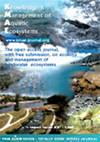三维耦合水动力-生态模型对湖泊水质评价采样方案代表性的贡献
IF 1.7
3区 环境科学与生态学
Q3 FISHERIES
引用次数: 10
摘要
根据欧洲水框架指令(WFD),研究了时空异质性对湖泊生态状况评价的影响。提出了一种基于三维水动力与生态耦合模型的湖泊生态状况变化评价方法,并对日内瓦湖(法国/瑞士)最具代表性的采样站进行了定位。利用自由软件Delft3D对湖泊生态状况评价中使用的5个变量进行模拟。数值模拟结果表明,基于管制监测站叶绿素a和总磷浓度的模拟生态状况取决于采样日期的选择。结果还表明,生态状况的空间异质性较强,沿东西梯度由“差”到“好”。最后,数值模拟结果表明,日内瓦湖平均理论生态质量最具代表性的点位于流域上部中心,靠近历史采样站。本文章由计算机程序翻译,如有差异,请以英文原文为准。
Contribution of 3D coupled hydrodynamic-ecological modeling to assess the representativeness of a sampling protocol for lake water quality assessment
This study deals with the impact of spatio-temporal heterogeneities on the assessment of lake ecological status according to the European water framework directive (WFD). A method, based on three-dimensional coupled hydrodynamic and ecological modeling, is presented to assess the variability of lake ecological status, and to locate the most representative sampling station of Lake Geneva (France/Switzerland). Five variables used in the lake ecological status evaluation were simulated by using the free software Delft3D. The numerical simulation results showed that the simulated ecological status based on chlorophyll a and total phosphorus concentrations measured at the regulatory monitoring station depend on the choice of the sampling date. Results also indicated a strong spatial heterogeneity in ecological status that varies from “poor” to “good” along an East-West gradient. Finally, the numerical simulation results showed that the most representative point of a mean theoretical ecological quality for Lake Geneva would be located in the center of the upper basin, close to the historical sampling station.
求助全文
通过发布文献求助,成功后即可免费获取论文全文。
去求助
来源期刊

Knowledge and Management of Aquatic Ecosystems
环境科学-海洋与淡水生物学
CiteScore
3.70
自引率
5.60%
发文量
22
审稿时长
>12 weeks
期刊介绍:
Knowledge and Management of Aquatic Ecosystems (KMAE-Bulletin Français de la Pêche et de la Pisciculture since 1928) serves as a foundation for scientific advice across the broad spectrum of management and conservation issues related to freshwater ecosystems.
The journal publishes articles, short communications, reviews, comments and replies that contribute to a scientific understanding of freshwater ecosystems and the impact of human activities upon these systems. Its scope includes economic, social, and public administration studies, in so far as they are directly concerned with the management of freshwater ecosystems (e.g. European Water Framework Directive, USA Clean Water Act, Canadian Water Quality Guidelines, …) and prove of general interest to freshwater specialists. Papers on insular freshwater ecosystems and on transitional waters are welcome. KMAE is not a preferred journal for taxonomical, physiological, biological, toxicological studies, unless a clear link to ecological aspects can be established. Articles with a very descriptive content can be accepted if they are part of a broader ecological context.
 求助内容:
求助内容: 应助结果提醒方式:
应助结果提醒方式:


